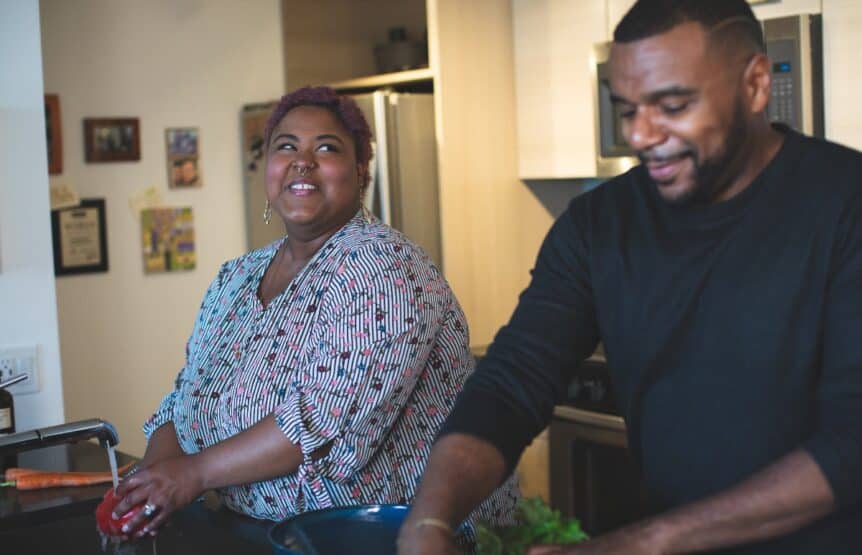Contrary to popular belief, it’s natural for couples to run into bumps in the road, especially as your relationship grows and progresses over time. Many couples panic at the first sign of communication mishaps — but the important thing to remember is, arguments are a sign that one or both partners are trying to have their needs met. So how do you fix poor communication in a relationship? The good news is that most arguments are rooted in trust and communication issues, which can be strengthened over time with the right methods. That’s why couples therapy communication techniques are so important to reach for as disagreements arise. Knowing how to communicate effectively in a romantic relationship isn’t something that most people know naturally, but rather a skill that’s developed over time in a trusting relationship.
The goal of communication techniques
Typically one person in the couple (sometimes both!) feel that couples counselling communication exercises are fluffy — but they’re actually rooted in research and science. Modern systematic observation of couples relationships date all the way back to the 1970’s and have continued to develop over time. Couples counselling brings those findings into tangible exercises to help build trust, encourage clear communication, and develop a deeper understanding for your partner’s needs.
Everyone wants a strong relationship. Couples therapy communication techniques are how you get there. To have an open and honest relationship, the couple needs to feel like they can communicate freely and show vulnerability. Reach for these exercises when things get tough or unclear within your relationship.
8 couples therapy communication techniques for a stronger relationship
Use ‘I’ statements
Using ‘I’ statements is one of the most well-known and practiced communication exercises in every kind of relationship. It’s natural for many people to immediately feel attacked when faced with criticism — this is something we must unlearn. ‘I’ statements release blame, put the responsibility back on the communicating individual, and bring the focus of the conversation on how each person is feeling. The format is simple yet effective and is flexible enough to be used in almost any context.
How to make an ‘I’ statement
I feel _____ (emotion) when you ______ (specific action or behaviour). What I need is ______ (action or behaviour request).
For example:
‘I feel frustrated when you promise to deal with the dishes but then leave them to pile up for a few days. What I need is for you to communicate when something comes up in your schedule that gets in the way of you being able to take care of this responsibility.”
This couples therapy communication technique begins by bringing the focus on one person and their needs. It then gives the other person very clear guidelines on what their partner needs to feel heard, validated, or helped next time. Sharing with ‘I’ statements takes the guesswork out of how to say something — especially when it’s uncomfortable or has the potential to come off as harsh. Remember, these don’t always have to be negative! ‘I’ statements are an amazing way to ask for more of an action or behaviour you’re loving in the relationship. Give it a go next time you want to ask your partner for something.
Practice active listening
Active listening is when couples take turns sharing their thoughts, feelings, or desires while the other listens intently. One person can start by taking under 60 seconds to share a basic request, like the need for more alone time, physical intimacy, or more experiences together. The second person should keep an open mind while listening and not place judgement or blame. When the first person is done sharing, the second person repeats back exactly what they heard to summarize the main ideas and clarify what was truly understood from the conversation. This gives the first person an opportunity to outline what was correctly understood and what wasn’t. Person two can then ask open-ended questions until the couple reaches true understanding. When person one is content and feels heard, person two gets a chance to practice the same exercise.
The goal is for both partners to leave the conversation feeling heard and having shared one thing for each other to work on. Couples can follow up in a week or two to see how they’ve made progress towards fulfilling each other’s requests.
Allow your partner to speak
The key here: do not interrupt! One of our most core needs is to feel heard and understood. This couples therapy communication technique aims to get partners to slow down and really get the other person’s perspective. Try it when you’ve hit a disagreement and need to sort out conflict. To start, set a timer and allow your partner to speak uninterrupted for 5-10 minutes. This is where those active listening skills come in. While person one is talking, person two should be doing their best to understand — not just waiting their own turn to speak. Person two can move the conversation forward by asking clarifying open-ended questions, for example:
- Why did those feelings come up for you?
- Have you felt like this in your past?
- What can I do to support you in this?
Share what you’ve been withholding
This is another communication exercise for couples to try together. To get started, write down 3 things you’ve been withholding from your partner: two positives and one negative. Try to think of things that have occured in the last few days so the events and behaviours are fresh for both of you. It’s important that the ‘negative’ isn’t a strong point of contention — something small that you held back or assumed wasn’t enough of a big deal to share (this isn’t the time to bring up a major gripe or a central issue). Finally, when considering what to share, be sure you’re choosing items that your partner can actually act on. Ready to share? Get right to the point and keep communication short to keep things as clear as possible.
After sharing, take 20-30 minutes away from each other to reflect on what the other person communicated. The goal of this couples communication therapy technique is for each partner to reflect on why the other chose to share those specific behaviours, and how they can show up better for each other.
Discover your love languages together
Every person gives and receives love differently, and knowing your partner’s love languages is one of the most direct routes to strengthening a bond. This exercise developed by Tina Tessina, PhD and author, allows couples to pick up specific behaviours that the other person appreciates, needs, and wants more of.
Sit together and have one person begin the exercise by finishing the sentence: “I feel loved by you when _____”. Person two follows up by saying simply “Thank you”. The reason for the ‘thank you’ response is to prevent prasing, criticizing, making excuses or blaming how your partner feels most loved. Simply hearing the statement and letting it be, creates a high level of respect for each other’s needs.
It’s now person two’s turn to complete the same exercise by finishing the sentence with something they love and appreciate. Couples can repeat this exercise for 10-15 minutes, or for as long as it feels good for both partners. Go with your instinct here — don’t think too long and hard about it and you’ll find your body will take over remembering moments that you cherished. If you’re stuck, just pass that round and give your partner the floor.
Couples can follow-up with questions to bond further:
- Were you surprised by anything that your partner shared?
- Did you develop a better understanding of what more to do for your partner?
- How did it feel for you to share what you need to feel loved?
Pay attention to body language
Not all communication happens through words. Body language is a strong non-verbal form of communication that couples can strengthen over time. Pay attention to how your partner behaves in different situations, and what that can mean for them.
Questions to consider:
- Do their moods change under different circumstances?
- Did their tone of voice change when discussing a certain topic? How did it change — do they sound nervous, frustrated, or like they’re withholding something?
- Are they carrying their body differently in how they walk and move?
Extended eye contact exercise
A couples communication method to strengthen non-verbal communication is to try an extended eye contact exercise. Before you try this, ensure both of you are in a calm mood. It supports the exercise and boosts your bond to do a calming routine beforehand, like meditating, going for a leisurely walk, or enjoying a cup of tea together. When you’re ready, sit across from your partner in a comfortable position and make eye contact. Maintain your gaze for up to five minutes without speaking or breaking eye contact. Fair warning, this can feel a little uncomfortable at first. You may feel the urge to laugh or look away, but hang in there. The magic happens once the discomfort passes. After the exercise, it’s important to discuss what came up for both of you.
Debriefing questions:
- How did you feel throughout the exercise?
- How did the exercise help you feel more connected to your partner?
- What non-verbal cues were you able to pick up on?
Body language speaks loudly. Listen up by tuning into your partner’s behaviours and gestures.
Set up a weekly meeting
This may sound too robotic and structured for some couples, but it creates the perfect environment to communicate what’s happening for each partner in the relationship. During these meetings, couples can share 5 good things they experienced since the last meeting, and one thing to work on. This 5:1 ratio of good to bad is key — you don’t want these meetings to turn into blame sessions. Remember to incorporate effective communication techniques like ‘I’ statements, active listening, avoiding interrupting, and maintaining eye contact. You can even take this time to work on the previously mentioned exercises like ‘I Feel Loved by You When’. This is a time for you to bond, express gratitude, and work toward relationship goals together. Use this time to speak your mind and ensure your partner feels heard too.
Strengthen your relationship with couples therapy communication techniques
These communication tools for couples will strengthen the relationship over time and clarify disagreements before they turn into a major conflict. Having a deep mutual understanding is what keeps the relationship satisfying over time.
How do you teach couples to communicate? By creating time for and incorporating these couples counselling communication exercises into your regular conversations. These tools take repetition and getting used to — and that’s why working them into your routines will provide the biggest opportunity for success. Remember: communication is a skill, and like any other skill, it requires practice. Flex those communication muscles together by trying these couples therapy communication techniques and watch your relationship grow, evolve, and improve.
Wellin5’s online counsellors are equipped to support you through every step in your relationship as a couple. Every couple struggles with different issues, which is why Wellin5 takes a custom approach to counselling. Get matched with a counsellor who fits your specific relationship needs and begin your first session in just 1-3 days. Learn more about Wellin5 and meet the counsellors.
Ready to strengthen your relationship? Get matched to your counsellor.



